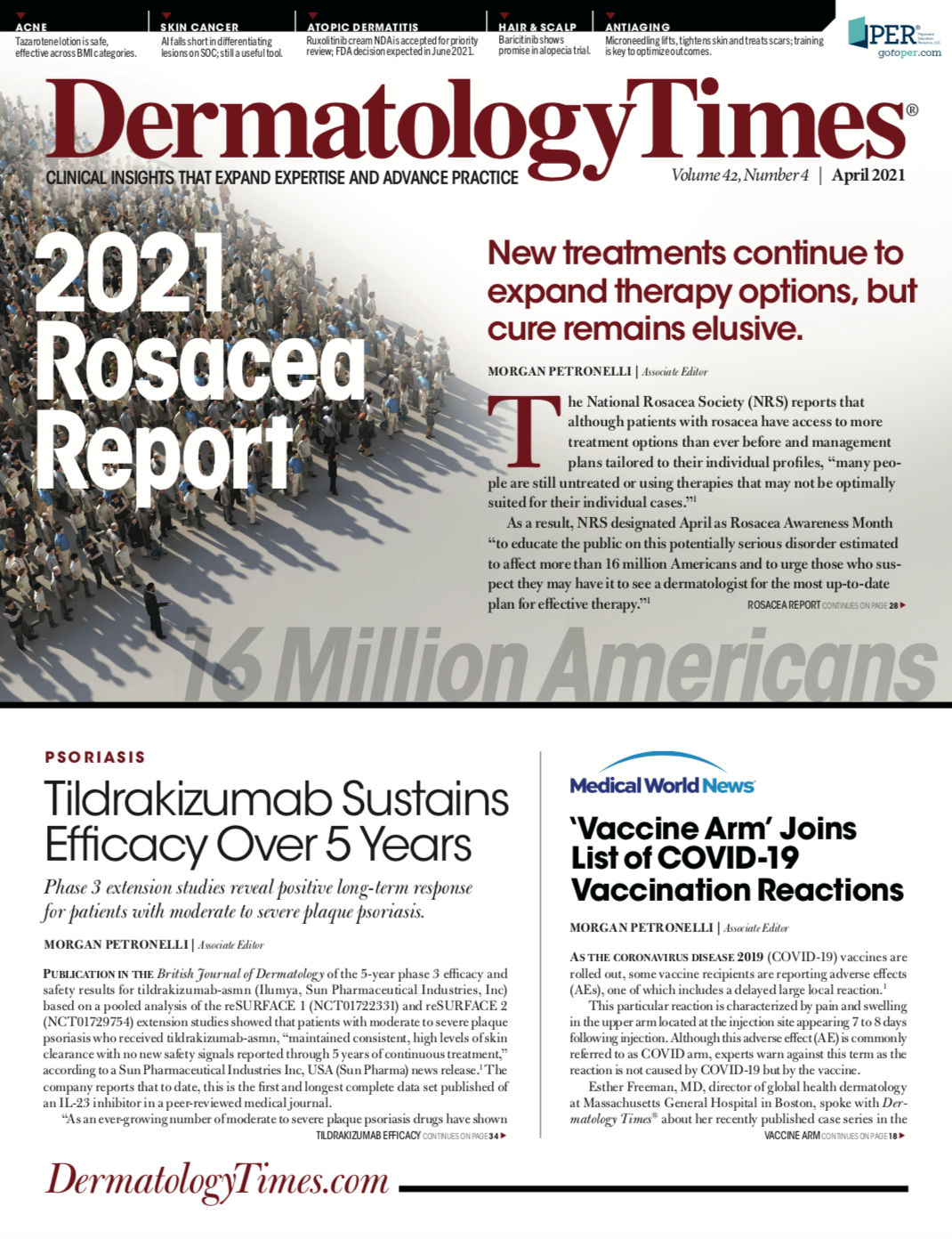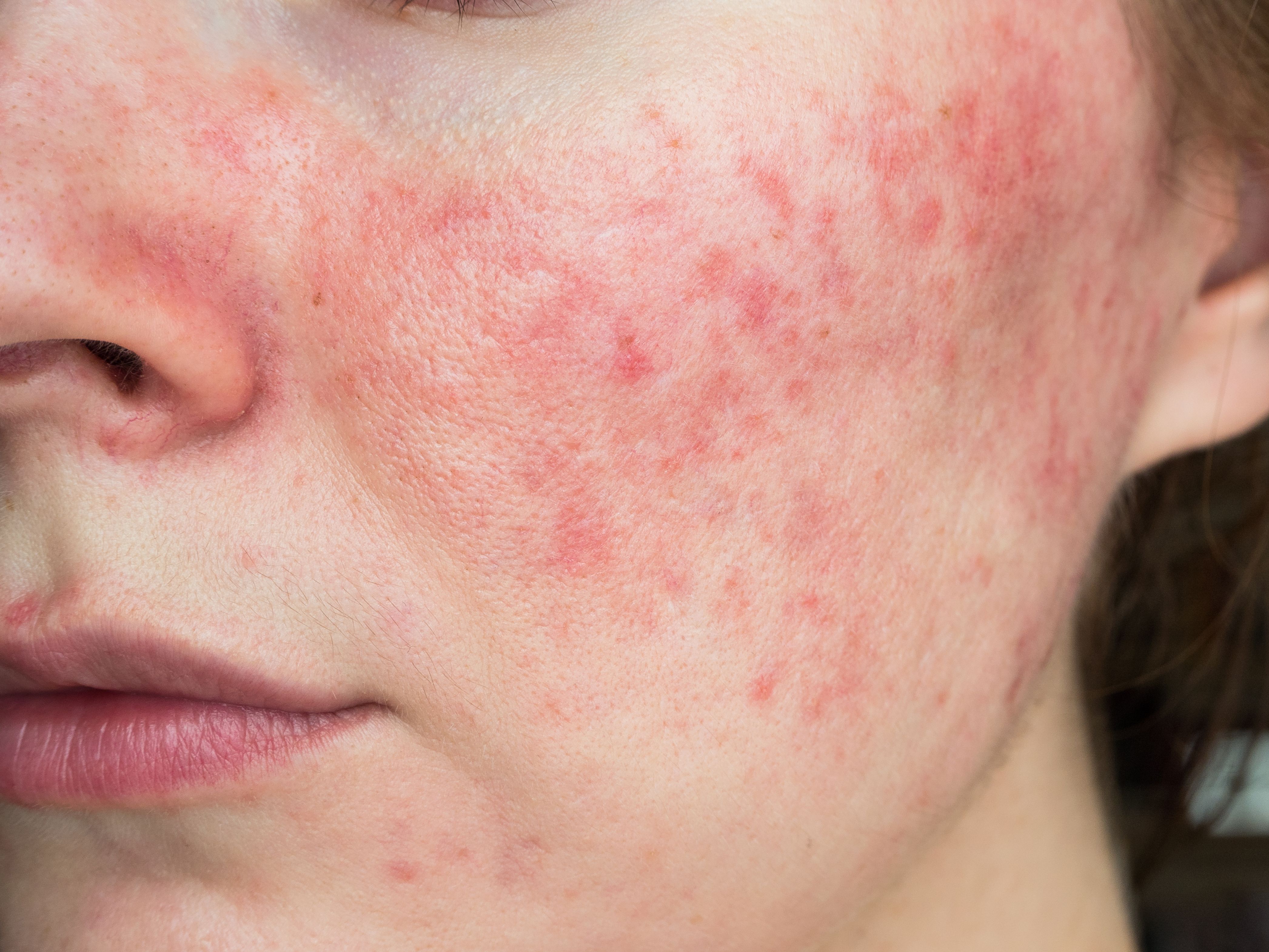- Case-Based Roundtable
- General Dermatology
- Eczema
- Chronic Hand Eczema
- Alopecia
- Aesthetics
- Vitiligo
- COVID-19
- Actinic Keratosis
- Precision Medicine and Biologics
- Rare Disease
- Wound Care
- Rosacea
- Psoriasis
- Psoriatic Arthritis
- Atopic Dermatitis
- Melasma
- NP and PA
- Skin Cancer
- Hidradenitis Suppurativa
- Drug Watch
- Pigmentary Disorders
- Acne
- Pediatric Dermatology
- Practice Management
- Prurigo Nodularis
- Buy-and-Bill
Publication
Article
Dermatology Times
2021 Rosacea Report
Author(s):
New treatments continue to expand therapy options, but a cure remains elusive.
The National Rosacea Society (NRS) reports that although patients with rosacea have access to more treatment options than ever before and management plans tailored to their individual profiles, “many people are still intreated or using therapies that may not be optimally suited for their individual cases.”1
As a result, NRS designated April as Rosacea Awareness Month “to educate the public on this potentially serious disorder estimated to affect more than 16 million Americans and to urge those who suspect they may have it to see a dermatologist for the most up-to-date plan for effective therapy.”1
In an exclusive interview with Dermatology Times®, Richard Gallo, MD, PhD, discusses the modalities and management strategies that are improving outcomes for this challenging skin disease. Gallo is the Irma Gigli Distinguished Professor and chairman of the Department of Dermatology at the University of California San Diego School of Medicine, an NRS trustee, and a member of the Dermatology Times® editorial advisory board.
Q: What’s the biggest hurdle between advances in rosacea treatment/management and cure?
Gallo: That depends in part on what one would consider as “cure.” If you consider cure to mean adequate treatment of all the phenotypes and symptoms, then we’re getting closer and closer. For some patients, we could achieve that now. If you consider cure the absence of recurrence of the phenotype, without any type of treatment, I think we’re still 5 to 10 years away.
Q: What’s new in terms of treatment?
Gallo: As an investigator who’s been involved in rosacea research for over 2 decades, I believe there’s a lot more opportunity to improve treatment for this disease, particularly figuring out strategies to inhibit the trigger and treating the redness associated with rotation.
Q: NRS predicts continued growth in rosacea cases, and research projects the rosacea treatment industry will be worth $2.6 billion by 2025.2 What’s driving that?
Gallo: It’s growing on the back of rising incidence of disease, an aging population, and unhealthy eating habits. But environmental exposure and lack of recognition of the disease also [play a big role]. The NRS and other resources have ongoing initiatives to raise awareness, but there’s a lot more to do.
Q: Are people with skin of color affecting those increases?
Gallo: Yes, dark-skinned patients, Black [people], and other patient populations with Fitzpatrick scores of IV to VI [rosacea has been very much underdiagnosed in], primarily because of an inability of many dermatologists to detect the erythema associated with rosacea on skin of color. One of the biggest things we can do is increase awareness among dermatologists and improve training in residency programs to address that.
Q: With all the concerns about accessibility and affordability, what can dermatologists do to match the right drug with the right patient?
Gallo: Drugs get on formulary partly based on cost of course—OK, largely based on costs—but also based on hard data for the pharmacists on the formulary committee to assess the efficacy of different drugs. There needs to be increased support for research that clearly defines the benefits of alternative treatments, indicates to the people making the decision which drugs to include, defines what goes on in formulary, and identifies what different combinations of drugs need to be available for adequate treatment. That is all essential for the best care of rosacea sufferers.
Q: Will coronavirus disease 2019 (COVID-19) have a lingering impact on rosacea, including limiting research funding and the ability to conduct in vivo studies?
Gallo: The necessary restrictions put in place to limit the pandemic greatly interfered with both laboratory-based and clinical trials. So COVID-19 has had a pretty significant impact on the scientific community. Governmental priorities for spending on medical research have shifted somewhat to those aligned with COVID-19— which, of course, I believe is appropriate. But on the other hand, perhaps this situation helps increase the general public’s recognition of the importance of medical research. There may be some opportunities there. Mask wearing is a big issue. It’s quite likely that we’ll see the general population wearing masks more frequently for a long time. Masks and the change in facial environment that masks induce [are] likely to be recognized increasingly as a trigger for rosacea.
Q: Many of NRS educational materials focus on diagnostic guidelines as well as treatment and management. what are some factors that may be overlooked?
Gallo: It’s not uncommon for a dermatologist to interact with a rosacea sufferer who’s had prior experience with chronic use of high- dose antibiotics and, of course, the use of such high-dose antibiotics promotes antibiotic resistance. One of the important things to explain to patients is that rosacea is not an infectious disease. We’re not attempting to eliminate all the bacteria or other organisms, such as mites that live on the skin. These are a natural part of the skin microenvironment. The treatment for rosacea aims to decrease the ability of that environment to trigger rosacea. That can be a little bit different for each person. Patients need to understand that a trial-and-error approach is necessary.
Q: NRS is conducting a survey on the impact of rosacea on social situations.3 what tips do you have for helping patients address this concern?
Gallo: Community forums and organizations such as NRS have been really, really important in helping patients when they get the diagnosis of rosacea to connect with other people who have this skin disease. One of the most important aspects of treating patients with rosacea is to let them know they’re not alone and to acknowledge that the impact on their well-being can be quite dramatic. Videoconferencing has, perhaps, exacerbated the situation. People are expected to be seen very close up in their computer monitor. In many cases, that amplifies the redness of rosacea, the papules, and the pustules. That’s not just potentially embarrassing; it can interfere with performing a critical part of their occupations.
Q: What will be the biggest headlines about rosacea in 2021?
Gallo: I don’t have a crystal ball, but I wish I knew. My dream would be that a cure for rosacea would be discovered, but I don’t think that’s going to happen. I do think we’ll see a number of new treatment options.
Disclosure:
Gallo reported no relevant or financial disclosures.
References:
1. Rosacea awareness month to highlight broad range of treatment options. News release. National Rosacea Society. February 2021. Accessed
March 13, 2021. https://www.rosacea.org/press/2021/february/ rosacea-awareness-month-to-highlight-broad-range-of-treatment-options
2. Rosacea treatment market worth $2.6 billion by 2025 |CAGR 6.8%. News release. Grand View Research. January 2019. Accessed March 20, 2021. https:// www.grandviewresearch.com/press-release/global-rosacea-treatment-market
3. The impact of rosacea on social situations. National Rosacea Society. Accessed March 20, 2021. https://www.surveymonkey.com/r/9L57Q3P







